
Gibbons in Myanmar hold a special place in cultural folklore, revered as forest spirits symbolizing pristine environments in significant tales. These narratives, depicting these agile and charming primates, have played a crucial role in shielding them from poaching in certain regions of the country. Cultural taboos, rooted in these stories, discourage their killing by highlighting the gibbons’ human-like features or warning of consequences like crop failure and family misfortune.
Despite these cultural safeguards, a recent study sheds light on a disheartening reality: Myanmar’s gibbons are teetering on the brink of extinction—a distressing trend mirrored across all primate species inhabiting the country.
Myanmar, positioned at the convergence of South Asia, China, and Southeast Asia, stands as a biodiversity hotspot. The nation boasts a rich primate diversity, hosting 20 recorded species within its borders, earning it the status of the seventh most primate-rich country in Asia. However, an alarming 90% of the gibbons, slow lorises, langurs, macaques, and snub-nosed monkeys dwelling in Myanmar face the looming threat of extinction, classified as either vulnerable, endangered, or critically endangered on the IUCN Red List.
The study underscores the urgent need for concerted efforts to protect these primates, as well as the researchers and conservationists toiling under challenging conditions to safeguard them. Without substantial action, both for the animals and those devoted to their preservation, the future appears bleak for Myanmar’s primate populations.

Deforestation, habitat degradation, and hunting for both subsistence and the illegal wildlife trade emerge as primary threats, as outlined in a study published in Global Ecology and Conservation. The research underscores the evident escalation of habitat loss in Myanmar, exacerbated by a lack of governance, accountability, and regulation, particularly following the military coup in February 2021. This political upheaval has triggered a surge in natural resource extraction, particularly in densely forested border regions that serve as vital wildlife sanctuaries.
Drawing on a comprehensive literature review and interviews with leading primate experts in Myanmar, the study reveals that populations of three key species persist in small, isolated fragments of their vanishing habitats. Notably, the Popa langur (Trachypithecus popa), a species newly described by scientists in 2020, is precariously clinging to existence across four isolated patches in Myanmar’s central plains, with a population of fewer than 260 individuals. The outlook for the other two species, Shortridge’s langur (Trachypithecus shortridgei) and the Myanmar snub-nosed monkey (Rhinopithecus strykeri), is equally grim.
While these three species face imminent threats, the study highlights a concerning lack of research information on the whereabouts and status of approximately 15 other primate species, hindering targeted conservation actions.
The imperative to safeguard Myanmar’s primate populations extends beyond averting extinction; it holds critical importance for broader ecosystem health. Co-author Susan Cheyne, vice chair of the IUCN Primate Specialist Group Section on Small Apes, emphasizes the role of primates as “gardeners of the forest.” Primates play a vital role in seed dispersal and flower pollination, contributing to natural forest recovery and regeneration. Additionally, as large-bodied primates are often among the first casualties in deteriorating ecosystems, they serve as essential indicators of the overall health of our biosphere.

Primates also carry significant cultural value as our closest living relatives. According to Cheyne, there exists an emotional connection with these creatures due to their striking similarity to humans in terms of behavior and ecology. This connection goes beyond evolutionary proximity, extending into a rich cultural tapestry woven over thousands of years, with numerous tales featuring primates.
Addressing knowledge gaps is crucial to reversing population declines, and despite the challenges posed by restricted travel for foreign scientists in Myanmar, progress has been made. Cheyne notes a wealth of primatology expertise within Myanmar, indicating that research has persisted. However, a critical challenge lies in the lack of national funding for conservation efforts from the Myanmar government and the reluctance of international donors to support projects in the country due to political concerns. This lack of support leaves the existing expertise largely untapped.
The insufficiency of funding not only impedes the work of local experts devoted to primate conservation in Myanmar but also stifles the potential of the next generation of primatologists. Without adequate training and support, aspiring conservationists are unable to develop their careers. Cheyne emphasizes the importance of not abandoning Myanmar due to its challenging working conditions, as doing so would be a disservice to the dedicated conservationists striving to protect its unique primate populations.

Out of 76 academic studies on Myanmar’s primate species, only 17% involved researchers within the country, as revealed by the study. The scarcity of national funding poses a significant barrier, compelling researchers to seek affiliations with international NGOs or conservation groups to advance their projects. Even when projects do proceed, they encounter challenges such as language barriers, limited internet access, and restricted access to academic literature.
Despite the challenging landscape for primates and wildlife conservation in Myanmar, Cheyne identifies a few reasons for optimism. Although data is limited for most species, emerging knowledge, particularly about gibbons, suggests a broader distribution than previously understood, with strongholds in protected areas.
Furthermore, the active involvement of local groups in Myanmar dedicated to forest land management for conservation purposes provides a glimmer of hope. Cheyne emphasizes that having local communities as partners provides a robust foundation for progress. Initiatives like the Karen Wildlife Conservation Initiative and Wildlife Asia, collaborating with local communities and WWF Myanmar, exemplify this collaborative approach. For instance, they are working together to safeguard white-handed gibbons (Hylobates lar) from the risk of electrocution by insulating power lines near forests in southern Myanmar.

The research team has put forth a set of recommendations to enhance the conservation landscape for Myanmar’s primates and the tireless researchers and conservationists striving to protect them. Key suggestions include fostering international collaborations to bolster the expertise of local primatologists, promoting fair and transparent partnerships through clear codes of conduct, drawing lessons from successful projects in neighboring countries, and disseminating information about effective conservation strategies globally. Additionally, the team advocates for raising the profile of research conducted by Myanmar-based researchers by making publications open access and readily accessible.
Cheyne emphasizes the importance of local researchers reaching out for support, encouraging them to seek assistance from groups like the IUCN Primate Specialist Group, which can facilitate the exchange of valuable information and knowledge.
In terms of prioritizing conservation efforts, the authors recommend channeling resources towards species such as Phayre’s langurs (Trachypithecus phayrei) and its Shan state subspecies (T. p. shanicus), dusky langurs (Trachypithecus obscurus), Indochinese gray langurs (Trachypithecus crepusculus), Shortridge’s langurs, Skywalker hoolock gibbons (Hoolock tianxing), and white-handed gibbons.
The overarching message underscores that active conservation initiatives are underway in Myanmar, driven by the pressing needs of wildlife. Cheyne stresses the importance for funders not to perceive Myanmar as an inaccessible zone. Dispelling assumptions that Myanmar is off-limits is crucial for supporting dedicated conservationists who require assistance and encouragement to effectively carry out their vital work.
